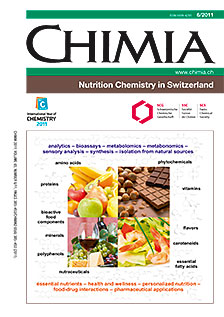Exploring Natural Products for New Taste Sensations
DOI:
https://doi.org/10.2533/chimia.2011.407Keywords:
(r)-2-(carboxymethylamino)propanoic acid, Dihydroumbellulols, Flavor design, Polygodial, Trigeminal and taste propertiesAbstract
This paper discusses the discovery of uncommon taste or trigeminal active compounds and their associated sensory analysis using human tasting panels with the aim of enhancing the over all taste experience whilst reducing where possible the sugar and salt content of foods. The first example outlines the discovery of the sensory quality attributes of (R)-2-(carboxymethylamino)propanoic acid, named (R)-strombine, as assessed by a panel of 47 subjects to confirm its contribution to the typical taste of scallop muscle. The second example discusses the pungency and trigeminal effect of polygodial, which is compared with piperine and capsaicin, as well as the elucidation of a new structure eliciting a trigeminal effect, (±)-trans-2,3,3a,7a-tetrahydro-1H-indene-4-carbaldehyde, discoveredin Amomum tsao-ko. Finally, the time intensity trigeminal effect of (–)-menthol is compared with (1R,2RS,4RS)-1-isopropyl-4-methylbicyclo[3.1.0]hexan-2-ol, named dihydroumbellulol, a new cooling compound obtained by hemi-synthesis from umbellulone extracted from Umbellularia californica Nutt.Downloads
Published
2011-06-29
Issue
Section
Scientific Articles
License
Copyright (c) 2011 Swiss Chemical Society

This work is licensed under a Creative Commons Attribution-NonCommercial 4.0 International License.
How to Cite
[1]
C. Starkenmann, I. Cayeux, A. A. Birkbeck, Chimia 2011, 65, 407, DOI: 10.2533/chimia.2011.407.







